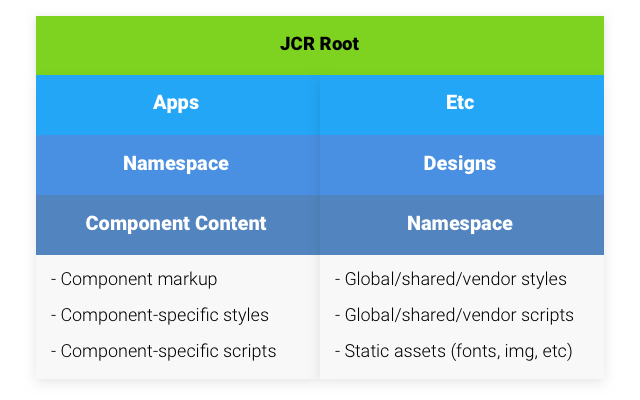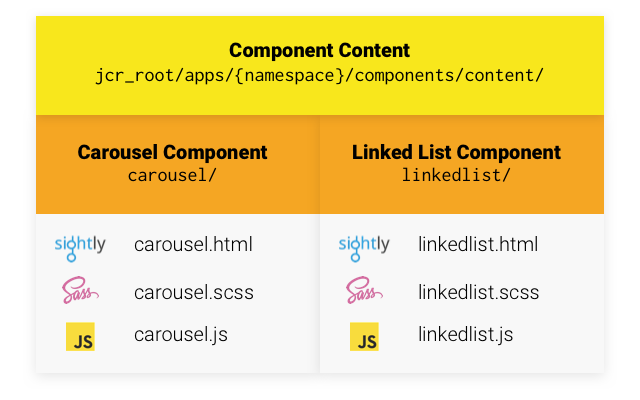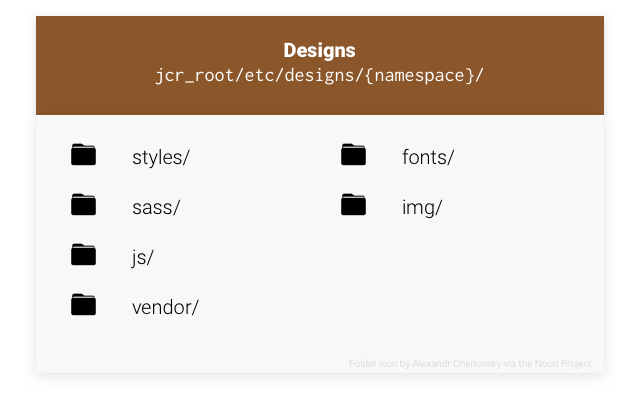- Simplify your build process using some of AEM's built-in features.
- Use a Maven Sass plugin so you're not limited to plain-old CSS or forcing back end devs to deal with gulp builds.
- Create a simplified and optional gulp workflow that will sling updated files to AEM.
There are a few solutions to this problem, one being (shameless plug) Iron (fe) which is an AEM front end framework I helped out on that includes a component generator. Iron extracts the entire front end code out into a separate, independent space then builds, bundles and pushes your front end to AEM. It works for very complex projects however it's massive overkill for simple AEM implementations, requires some ramp-up time for devs to get use to its structure, and can also provides complications for back end developers and architects.
After trying out a lot of different architectures I came up with a slightly opinionated solution that has worked extremely well so far. It keeps things simple and goes back to the question of "what exactly is required for this project that AEM cannot provide out of the box?"
Let's take a look at what this will take care of:
- Sass for styles compiled via Maven build (no compiled code in source control, anyone/anything can run a build)
- JavaScript concatenation via AEM
- Predictable file structure
- Optional automagic builds and file deployment to AEM

- Component-specific templates, scripts, and styles are all within
jcr_root/apps/{namespace}/components/content - Global/utility styles and scripts, vendor libraries, and static assets are all within
jcr_root/etc/designs/{namespace}/


The designs section is a little more open to interpretation as every project is going to be different and everybody likes to structure things their own way. The one important caveat to note is that the main .scss file needs to be completely independent from the rest of the sass files, otherwise you'll wind up with every single one of your source .scss files being converted into .css files. Trust me, you don't want that. In the case of the diagram above, with this in mind the styles/ directory would contain 1 file: main.scss and that would import the files in the sass/ directory and get built into main.css.
Getting Sass to work
Now that we've got a general idea of where things should go we can start setting up some scaffolding and get an actual build running. We'll start with getting our Maven build compiling Sass first since that's the biggest hurdle.Before we continue, there are ways to have Maven download and install npm and everything necessary to run your build at run time, however I've seen this work inconsistently and I've heard it can cause issues on some environments. What we're after is a simplified solution that will run anywhere, anytime consistently.
I've tried a few different Maven plugins for Sass compilation, and so far my favorite has been the libsass-maven-plugin by @warmuuh. It's essentially just a wrapper for libsass so it's very robust in the options it provides, however there are some limitations that you may have to play around with to find workarounds.
All we have to do is add the plugin to our UI pom and configure it to use the correct files and paths.
<!-- /(namespace)-ui/pom.xml -->
<build>
<plugins>
<plugin>
<groupId>com.github.warmuuh</groupId>
<artifactId>libsass-maven-plugin</artifactId>
<version>0.1.6-libsass_3.2.4</version>
<executions>
<execution>
<id>compile-sass</id>
<goals>
<goal>compile</goal>
</goals>
<configuration>
<inputPath>${project.basedir}/src/main/content/jcr_root/etc/designs/(namespace)/styles</inputPath>
<includePath>${project.basedir}/src/main/content/jcr_root/etc/designs/(namespace)/sass:${project.basedir}/src/main/content/jcr_root/apps/(namespace)/components</includePath>
<outputPath>${project.basedir}/src/main/content/jcr_root/etc/designs/(namespace)/css</outputPath>
<outputStyle>compressed</outputStyle>
<generateSourceMap>true</generateSourceMap>
<sourceMapOutputPath>${project.basedir}/src/main/content/jcr_root/etc/designs/(namespace)/css</sourceMapOutputPath>
<omitSourceMapingURL>true</omitSourceMapingURL>
</configuration>
</execution>
</executions>
</plugin>
<!-- . . . -->
</plugins>
</build><inputPath>: Tell it to use our main files directory as the source. It will compile every single.scssfile inside of this directory, so its best to have your main file separated from the rest of your code for this reason.<includePath>: Set both our main source code directory (etc/designs/namespace/sass) and component content directory (apps/namespace/components) as paths the compiler should look in when handling an@importdeclaration.<outputPath>: Set where the compiled css file should be saved.<outputStyle>: Tell it to compress (minify) the output.<generateSourceMap>: Have the compiler also generate a source map for easier debugging during development.<sourceMapOutputPath>: Tell the compiler where the compiled source map should be saved.<omitSourceMapingURL>: That property name isn't a typo. This just tells the compiler to not automatically inject the source map URL into the finished.cssfile. This was something that needs to be set to true and a URL manually added to the main sass file for Source Maps to work an, I found out the hard way.
bootstrap/ // The source code for our framework of choice.
_variables.scss // Site-wide Sass variables.
_mixins.scss // Any custom mixins your code requires.
_utils.scss // Utility classes such as floats, clears, show/hide classes.
components.scss // Component bulk-import file.
layout.scss // Layout-specific styles, such as page template scaffolding.
icons.scss // Custom icon declarations.
forms.scss // Global form styles.
typography.scss // Global typography such as headers, color options, links, etc.
globals.scss // Global styles that don't really fit in anywhere else.// etc/designs/namespace/sass/components.scss
/* . . . */
@import "content/carousel/carousel.scss";
@import "content/linkedlist/linkedlist.scss";
/* . . . */// etc/designs/namespace/styles/main.scss
// Custom Variables and mixins
@import "variables";
@import "mixins";
@import "icons";
// Bootstrap imports
/*
Removing vast majority of them since there are so many,
but you essentially just copy the entire `bootstrap.scss`
file into here with your own overrides scattered in between.
*/
@import "bootstrap/variables";
@import "bootstrap/mixins";
// More bootstrap imports...
// Core Overrides
@import "type";
@import "layout";
// Bootstrap Components...
// Globals
@import "utils";
@import "forms";
@import "globals";
// Components
@import "components";
/*!# sourceMappingURL=namespace/css/main.css.map */// etc/designs/namespace/sass/components.scss
@import "content/carousel/carousel.scss";
@import "content/linkedlist/linkedlist.scss";
@import "content/list/list.scss"; // Our new component// apps/namespace/components/content/list/list.scss
ul.namespace-list {
list-style: none;
padding-left: 0;
}- namespace-frontend.design: Main clientlib category containing all of the global styles and scripts.
- namespace-frontend.components: A complimentary design category that will be embedded into the main category.
- namespace-frontend.vendor: All of our vendor/external clientlibs.
<!-- etc/designs/namespace/.content.xml -->
<?xml version="1.0" encoding="UTF-8"?>
<jcr:root xmlns:sling="http://sling.apache.org/jcr/sling/1.0" xmlns:jcr="http://www.jcp.org/jcr/1.0" xmlns:rep="internal"
jcr:mixinTypes="[rep:AccessControllable]"
jcr:primaryType="cq:ClientLibraryFolder"
sling:resourceType="widgets/clientlib"
embed="[namespace-frontend.components]"
categories="[namespace-frontend.design]"
/># etc/designs/namespace/css.txt
#base=css
main.css
# etc/designs/namespace/js.txt
#base=js
main.js
utils.js
This should be pretty standard for anybody who has made clientlibs before, all we're doing is directing the clientlib to our files.<!-- etc/designs/namespace/vendor/.content.xml -->
<?xml version="1.0" encoding="UTF-8"?>
<jcr:root xmlns:sling="http://sling.apache.org/jcr/sling/1.0" xmlns:jcr="http://www.jcp.org/jcr/1.0" xmlns:rep="internal"
jcr:mixinTypes="[rep:AccessControllable]"
jcr:primaryType="cq:ClientLibraryFolder"
sling:resourceType="widgets/clientlib"
categories="[namespace-frontend.vendor]"
/>In typical AEM fashion, the libraries going in the vendor/ directory get split up into css/ and js/ directories, which we'll just include via the css.txt and js.txt files in the vendor root.
# etc/designs/namespace/vendor/js.txt #base=js bootstrap.carousel.js bootstrap.collapse.js jquery.validate.jsAdding component scripts
<!-- apps/namespace/components/content/linkedlist/js/.content.xml -->
<?xml version="1.0" encoding="UTF-8"?>
<jcr:root xmlns:sling="http://sling.apache.org/jcr/sling/1.0" xmlns:jcr="http://www.jcp.org/jcr/1.0" xmlns:rep="internal"
jcr:mixinTypes="[rep:AccessControllable]"
jcr:primaryType="cq:ClientLibraryFolder"
sling:resourceType="widgets/clientlib"
categories="[namespace-frontend.components]"
/># apps/namespace/components/content/linkedlist/js/js.txt
linkedlist.js
linkedlist.item.js
It's worth noting that the structure of the component directory is completely subjective. You can have something like:apps/namespace/components/content/linkedlist/
js/
.content.xml
js.txt
linkedlist.js
or:
apps/namespace/components/content/linkedlist/
.content.xml
js.txt
js/
linkedlist.js
The concept is the same, so use whichever structure works for you and your project.<!-- apps/namespace/components/page/global/head.html -->
<head data-sly-use.clientLib="${'/libs/granite/sightly/templates/clientlib.html'}">
<sly data-sly-unwrap data-sly-call="${clientLib.css @ categories='namespace-frontend.vendor'}" />
<sly data-sly-unwrap data-sly-call="${clientLib.css @ categories='namespace-frontend.design'}" />
</head><!-- apps/namespace/components/page/global/body.html -->
<body data-sly-use.clientLib="${'/libs/granite/sightly/templates/clientlib.html'}">
<div id="wrapper">
<header id="header" data-sly-include="header.html"></header>
<div id="content" class="container" data-sly-include="content.html"></div>
</div>
<footer id="footer" data-sly-include="footer.html"></footer>
<sly data-sly-unwrap data-sly-call="${clientLib.js @ categories='namespace-frontend.vendor'}" />
<sly data-sly-unwrap data-sly-call="${clientLib.js @ categories='namespace-frontend.design'}" />
</body>Now we have a working Sass build via Maven, component styles/scripts in predictable locations, connected global/utility styles/scripts and vendor libraries. If you have no need for Gulp automation for quicker builds and code deployment to AEM you should be ready to start developing. If not, all that's left is setting up our optional Gulp build.Gulp Automation for the time-savings
One of the things that really bugs me about most standard AEM setups is that if I need to make a 1-line change to some CSS, JavaScript or template my only options are using CRX/DE (yuck) or running a full Maven build (yuck). Let's bring this build into the modern era with a gulp setup that will automagically sling our compiled Sass and other files to AEM on file change so we're not stuck waiting for slow Maven build.For the bare minimum all you really need as far as npm packages go is gulp-slang to auto-sling the files to AEM, which you can then fire off in a task or watch block.
If you're interested in an example gulp file, we'll set up one with sass compilation, jslinting and auto-slinging whenever a style, script, or template is updated. First off we need to install some npm packages in our absolute project root and initialize our npm project:
npm init
# utils
npm install --save-dev gulp gulp-watch gulp-plumber gulp-rename gulp-util gulp-watch
# style-related
npm install --save-dev gulp-sass gulp-sourcemaps
# script related
npm install --save-dev jshint gulp-jshint
# aem related
npm install --save-dev gulp-slang// gulpfile.js
/* Requires */
var gulp = require('gulp'),
watch = require('gulp-watch'),
// Utilities
gutil = require('gulp-util'),
plumber = require('gulp-plumber'),
slang = require('gulp-slang'),
rename = require('gulp-rename'),
// Styles
sass = require('gulp-sass'),
sourcemaps = require('gulp-sourcemaps'),
// Scripts
jshint = require('gulp-jshint');// gulpfile.js, continued
/* Requires */
// . . .
/* Paths */
var root = 'namespace-ui/src/main/content/jcr_root/',
components = root + 'apps/namespace/components/',
designs = root + 'etc/designs/namespace/',
// Styles
cssPath = designs + 'css/',
sassPath = designs + 'sass/',
mainCss = designs + 'styles/main.scss',
cssBuild = cssPath + 'main.css',
cssSrcMaps = cssPath + 'main.css.map',
// Scripts
jsPath = designs + 'js/',
vendorPath = designs + 'vendor/',
// Images
imgPath = designs + 'img/';// gulpfile.js, continued
/* Requires */
// . . .
/* Paths */
// . . .
/**
* Helper: changeNotification
* Logs an event to the console.
*
* @param {String} fType - The file type that was changed.
* @param {String} eType - The event that occured.
* @param {String} msg - Short description of the actions that are being taken.
*/
function changeNotification(fType, eType, msg) {
gutil.log(gutil.colors.cyan.bold(fType), 'was', gutil.colors.yellow.bold(eType) + '.', msg);
}// gulpfile.js, continued
/* Requires */
// . . .
/* Paths */
// . . .
/* changeNotification */
// . . .
/**
* Task: `sass:build`
* Compiles the sass and writes sourcemaps.
*/
gulp.task('sass:build', function (cb) {
gulp.src(mainCss)
.pipe(plumber()) // Prevents pipe breaking due to error (for watch task)
.pipe(sourcemaps.init())
.pipe(sass({
outputStyle: 'compressed',
omitSourceMapUrl: true, // This is hardcoded in the main.scss due to resource path issues
includePaths: [sassPath, components]
}).on('error', sass.logError))
.pipe(sourcemaps.write('./', {
addComment: false
}))
.pipe(plumber.stop())
.pipe(gulp.dest(cssPath));
// Fire the callback Gulp passes in to tell it we're done
cb();
});
/**
* Task: `sass:sling`
* Slings the compiled stylesheet and sourcemaps to AEM.
*/
gulp.task('sass:sling', ['sass:build'], function () {
return gulp.src([cssBuild, cssSrcMaps])
.pipe(slang());
});
/**
* Task: `sass`
* Runs the sass build and slings the results to AEM.
*/
gulp.task('sass', ['sass:build', 'sass:sling']);// gulpfile.js, continued
/* Requires */
// . . .
/* Paths */
// . . .
/* changeNotification */
// . . .
/* Sass tasks */
// . . .
/**
* Task: `js:lint`
* Lints project JS, excluding vendor libs.
*/
gulp.task('js:lint', function () {
return gulp.src([components + '**/*.js', jsPath + '**/*.js'])
.pipe(jshint())
.pipe(jshint.reporter('default'));
});// gulpfile.js, continued
/* Requires */
// . . .
/* Paths */
// . . .
/* changeNotification */
// . . .
/* Sass tasks */
// . . .
/* JS tasks */
// . . .
/**
* Task: `watch`
* Watches the HTML, Sass, and JS for changes. On a file change,
* will run builds file-type dependently and sling the new files
* up to AEM.
*/
gulp.task('watch', function () {
gutil.log('Waiting for changes.');
// Set up our streams
var jsWatch = gulp.watch([components + '**/*.js', jsPath + '**/*.js'], ['js:lint']),
sassWatch = gulp.watch([components + '**/*.scss', mainCss, sassPath + '**/*.scss'], ['sass']),
markupWatch = gulp.watch([components + '**/**/*.html', components + '**/**/*.jsp']),
imgWatch = gulp.watch([imgPath + '**/*']);
// js needs to be linted
jsWatch.on('change', function (ev) {
changeNotification('JS file', ev.type, 'Linting code & slinging to AEM.');
return gulp.src(ev.path)
.pipe(slang(ev.path));
});
// Sass needs to get built and slung up
sassWatch.on('change', function (ev) {
changeNotification('Sass file', ev.type, 'Running compilation & slinging to AEM.');
});
// Markup just needs to be slung to AEM
markupWatch.on('change', function (ev) {
changeNotification('Sightly file', ev.type, 'Slinging file to AEM.');
return gulp.src(ev.path)
.pipe(slang(ev.path));
});
// Images just need to be slung to AEM
imgWatch.on('change', function (ev) {
changeNotification('Image file', ev.type, 'Slinging file to AEM.');
return gulp.src(ev.path)
.pipe(slang(ev.path));
});
});- gulp watch - Watches for changes to JavaSript, CSS/Sass, and HTML files, runs any necessary subtasks and slings the result to AEM.
- gulp sass - Builds all Sass files and slings the compiled stylesheet and source maps to AEM.
- gulp js:lint - Runs all JavaScript files against JSHint and outputs the results to the console.
If you'd like to check out the gulpfile more in-depth, you can view it in its entirety on Github. You can also browse through a full example of this hierarchy with all of the code from this post in place via this repo.
No comments:
Post a Comment
If you have any doubts or questions, please let us know.